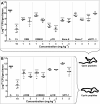In vivo efficacy of anuran trypsin inhibitory peptides against staphylococcal skin infection and the impact of peptide cyclization
- PMID: 25624332
- PMCID: PMC4356830
- DOI: 10.1128/AAC.04324-14
In vivo efficacy of anuran trypsin inhibitory peptides against staphylococcal skin infection and the impact of peptide cyclization
Abstract
Staphylococcus aureus is a virulent pathogen that is responsible for a wide range of superficial and invasive infections. Its resistance to existing antimicrobial drugs is a global problem, and the development of novel antimicrobial agents is crucial. Antimicrobial peptides from natural resources offer potential as new treatments against staphylococcal infections. In the current study, we have examined the antimicrobial properties of peptides isolated from anuran skin secretions and cyclized synthetic analogues of these peptides. The structures of the peptides were elucidated by nuclear magnetic resonance (NMR) spectroscopy, revealing high structural and sequence similarity with each other and with sunflower trypsin inhibitor 1 (SFTI-1). SFTI-1 is an ultrastable cyclic peptide isolated from sunflower seeds that has subnanomolar trypsin inhibitory activity, and this scaffold offers pharmaceutically relevant characteristics. The five anuran peptides were nonhemolytic and noncytotoxic and had trypsin inhibitory activities similar to that of SFTI-1. They demonstrated weak in vitro inhibitory activities against S. aureus, but several had strong antibacterial activities against S. aureus in an in vivo murine wound infection model. pYR, an immunomodulatory peptide from Rana sevosa, was the most potent, with complete bacterial clearance at 3 mg · kg(-1). Cyclization of the peptides improved their stability but was associated with a concomitant decrease in antimicrobial activity. In summary, these anuran peptides are promising as novel therapeutic agents for treating infections from a clinically resistant pathogen.
Copyright © 2015, American Society for Microbiology. All Rights Reserved.
Figures






References
Publication types
MeSH terms
Substances
Associated data
- Actions
- Actions
LinkOut - more resources
Full Text Sources
Other Literature Sources
Medical

